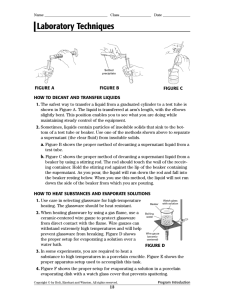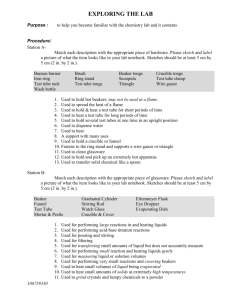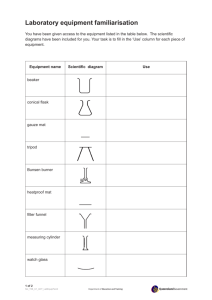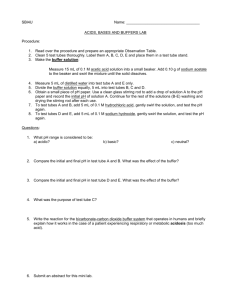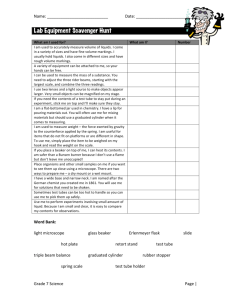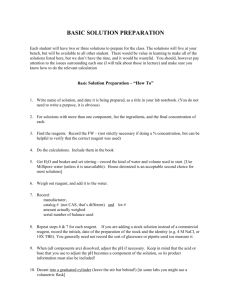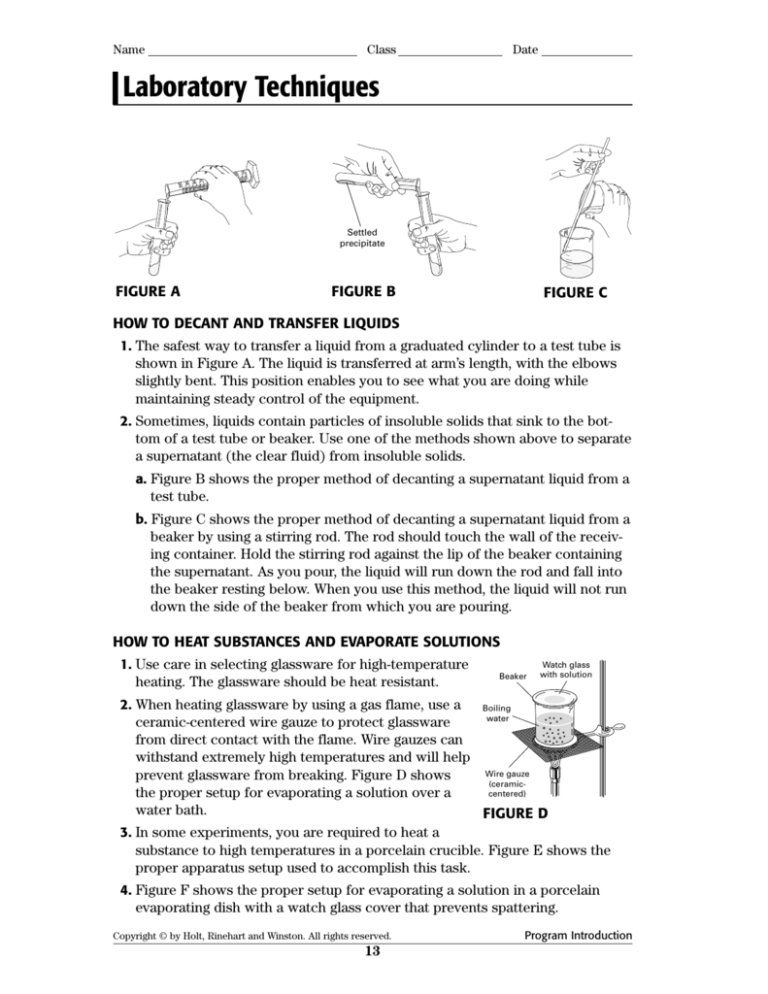
Name
Class
Date
Laboratory Techniques
;
Settled
precipitate
FIGURE A
FIGURE B
FIGURE C
HOW TO DECANT AND TRANSFER LIQUIDS
1. The safest way to transfer a liquid from a graduated cylinder to a test tube is
shown in Figure A. The liquid is transferred at arm’s length, with the elbows
slightly bent. This position enables you to see what you are doing while
maintaining steady control of the equipment.
2. Sometimes, liquids contain particles of insoluble solids that sink to the bottom of a test tube or beaker. Use one of the methods shown above to separate
a supernatant (the clear fluid) from insoluble solids.
a. Figure B shows the proper method of decanting a supernatant liquid from a
test tube.
b. Figure C shows the proper method of decanting a supernatant liquid from a
beaker by using a stirring rod. The rod should touch the wall of the receiving container. Hold the stirring rod against the lip of the beaker containing
the supernatant. As you pour, the liquid will run down the rod and fall into
the beaker resting below. When you use this method, the liquid will not run
down the side of the beaker from which you are pouring.
HOW TO HEAT SUBSTANCES AND EVAPORATE SOLUTIONS
1. Use care in selecting glassware for high-temperature
heating. The glassware should be heat resistant.
Beaker
Watch glass
with solution
2. When heating glassware by using a gas flame, use a
Boiling
water
ceramic-centered wire gauze to protect glassware
from direct contact with the flame. Wire gauzes can
withstand extremely high temperatures and will help
Wire gauze
prevent glassware from breaking. Figure D shows
(ceramiccentered)
the proper setup for evaporating a solution over a
water bath.
FIGURE D
3. In some experiments, you are required to heat a
substance to high temperatures in a porcelain crucible. Figure E shows the
proper apparatus setup used to accomplish this task.
4. Figure F shows the proper setup for evaporating a solution in a porcelain
evaporating dish with a watch glass cover that prevents spattering.
Copyright © by Holt, Rinehart and Winston. All rights reserved.
13
Program Introduction
Name
Class
Date
Laboratory Techniques continued
Crucible
Clay
triangle
Watch
glass
Evaporating
dish
Wire gauze
(ceramiccentered)
Low
flame
FIGURE E
FIGURE F
5. Glassware, porcelain, and iron rings that have been heated may look cool
after they are removed from a heat source, but these items can still burn your
skin even after several minutes of cooling. Use tongs, test-tube holders, or
heat-resistant mitts and pads whenever you handle these pieces of apparatus.
6. You can test the temperature of beakers, ring stands, wire gauzes, or other
pieces of apparatus that have been heated by holding the back of your hand
close to their surfaces before grasping them. You will be able to feel any
energy as heat generated from the hot surfaces. DO NOT TOUCH THE APPARATUS. Allow plenty of time for the apparatus to cool before handling.
HOW TO POUR LIQUID FROM A REAGENT BOTTLE
1. Read the label at least three times before
using the contents of a reagent bottle.
Stirring
rod
Stopper
Reagent
bottle
2. Never lay the stopper of a reagent bottle
on the lab table.
3. When pouring a caustic or corrosive
liquid into a beaker, use a stirring rod to
avoid drips and spills. Hold the stirring
rod against the lip of the reagent bottle.
Estimate the amount of liquid you need,
and pour this amount along the rod, into
the beaker. See Figure G.
Beaker
Reagent
label
FIGURE G
4. Extra precaution should be taken when handling a bottle of acid. Remember
the following important rules: Never add water to any concentrated acid,
particularly sulfuric acid, because the mixture can splash and will generate a
lot of energy as heat. To dilute any acid, add the acid to water in small quantities while stirring slowly. Remember the “triple A’s”—Always Add Acid to
water.
Copyright © by Holt, Rinehart and Winston. All rights reserved.
14
Program Introduction
Name
Class
Date
Laboratory Techniques continued
5. Examine the outside of the reagent bottle for any liquid that has dripped
down the bottle or spilled on the counter top. Your teacher will show you the
proper procedures for cleaning up a chemical spill.
6. Never pour reagents back into stock bottles. At the end of the experiment,
your teacher will tell you how to dispose of any excess chemicals.
HOW TO HEAT MATERIAL IN A TEST TUBE
1. Check to see that the test tube is heat resistant.
2. Always use a test tube holder or clamp when heating a test tube.
3. Never point a heated test tube at anyone, because the liquid may splash out of
the test tube.
4. Never look down into the test tube while heating it.
5. Heat the test tube from the upper portions of the tube downward, and continuously move the test tube, as shown in Figure H. Do not heat any one spot on
the test tube. Otherwise, a pressure buildup may cause the bottom of the tube
to blow out.
HOW TO USE A MORTAR AND PESTLE
1. A mortar and pestle should be used for grinding only one substance at a time.
See Figure I.
2. Never use a mortar and pestle for simultaneously mixing different substances.
3. Place the substance to be broken up into the mortar.
4. Pound the substance with the pestle, and grind to pulverize.
5. Remove the powdered substance with a porcelain spoon.
HOW TO DETECT ODORS SAFELY
1. Test for the odor of gases by wafting your hand over the test tube and cautiously sniffing the fumes as shown in Figure J.
2. Do not inhale any fumes directly.
3. Use a fume hood whenever poisonous or irritating fumes are present. DO
NOT waft and sniff poisonous or irritating fumes.
Test tube
Grind to
pulverize
Pound to
reduce size
Test tube
holder
Burner
Wafting
motion
FIGURE H
FIGURE I
Copyright © by Holt, Rinehart and Winston. All rights reserved.
15
FIGURE J
Program Introduction

